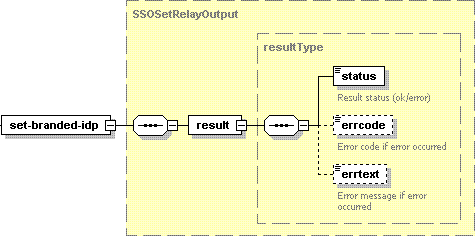Setting Branded IdP URL
Use the set-branded-idp operation to set the branded IdP for a specific site.
Request Packet Structure
A request XML packet setting the branded IdP URL for a site includes the set-branded-idp operation node:
<packet>
<sso>
<set-branded-idp>
...
</set-branded-idp>
</sso>
</packet>
The set-branded-idp node is presented by type SSOSetRelayInput (sso.xsd), and its graphical representation is as follows:

- The idp-url node is required. It specifies the branded IdP URL. Data type: base64.
- The http-request-domain node is required. It specifies the name of the site for which the branded IdP is set. Data type: string.
Note: The site must not exist in Plesk.
Remarks
The operation will associate a domain with a new branded IdP even if it was previously associated with another IdP.
Important: When creating request packets, put nodes and elements in the order they follow in the packet structure.
Response Packet Structure
The set-branded-idp node of the output XML packet is presented by type SSOSetRelayOutput (sso.xsd) and structured as follows:

- The result node is required. It wraps the response retrieved from the server. Data type: resultType (
common.xsd). - The status node is required. It specifies the execution status of the operation. Data type: string. Allowed values: ok | error.
- The errcode node is optional. It returns the error code if the operation fails. Data type: integer.
- The errtext node is optional. It returns the error message if the operation fails. Data type: string.
Samples
The packet that sets the branded IdP URL (http://sso.example.com:1180/) for site example.com looks as follows:
<packet version="1.5.2.0">
<sso>
<set-branded-idp>
<idp-url>aHR0cDovL3Nzby5leGFtcGxlLmNvbToxMTgwLw==</idp-url>
<http-request-domain>https://example.com:8443</http-request-domain>
</set-branded-idp>
</sso>
</packet>Response:
<packet version="1.5.2.0">
<sso>
<set-branded-idp>
<result>
<status>ok</status>
</result>
</set-branded-idp>
</sso>
</packet>
A negative response from the server can look as follows:
<packet version="1.5.2.0">
<sso>
<set-branded-idp>
<result>
<status>error</status>
<errcode>1026</errcode>
<errtext>The service is not installed.</errtext>
</result>
</set-branded-idp>
</sso>
</packet>
If the site does not exist in Plesk database, the response from the server looks as follows:
<packet version="1.5.2.0">
<sso>
<set-branded-idp>
<result>
<status>error</status>
<errcode>1013</errcode>
<errtext>HTTP Request site does not exist.</errtext>
</result>
</set-branded-idp>
</sso>
</packet>